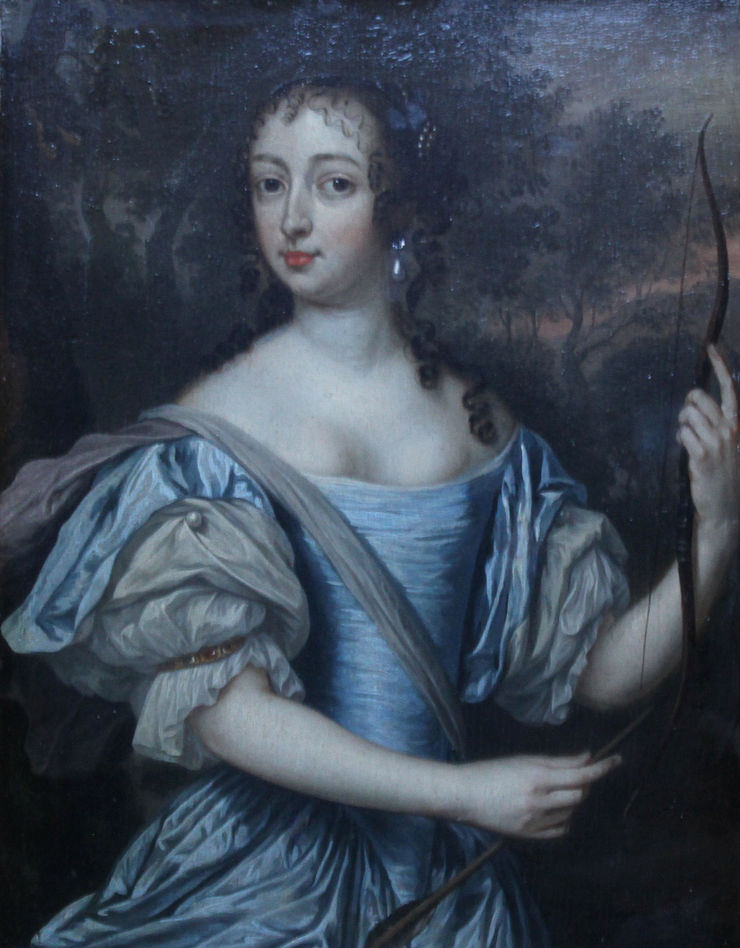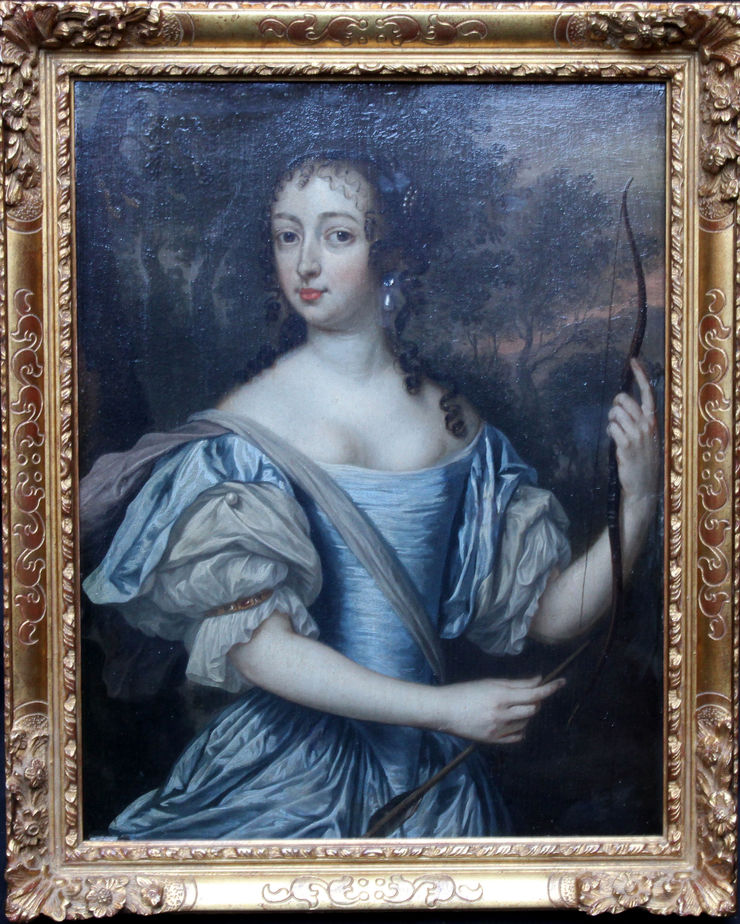Jan Mijtens (1614-1670)
| Artist Name | Jan Mijtens (1614-1670) |
|---|---|
| Title | Portrait of Dutch Princess Maria von Oranje Nassau |
| Description | This stunning Old Master oil portrait painting is by noted Dutch Golden Age painter Jan Mijtens. The portrait is of a significant historical figure, Maria Von Oranje Nassau and her history is below. She is depicted wearing a stunning blue silk dress, holding a bow and arrow and is set in a landscape. The impasto glistens on her earring. His technique was particuarly suited to the fine rendering of detail and his paintings are a precious historical record of that period. The painting is signed lower left.
Maria of Nassau or Maria of Orange-Nassau (1642, The Hague - 1688, Kreuznach) was a Dutch princess of the house of Orange and by marriage pfalzgräfin or countess of Simmern-Kaiserslautern. Maria was the youngest daughter of Amalia of Solms-Braunfels and her husband Frederick Henry, Prince of Orange. Her father was already in his late fifties when she was born and died when she was only four. She was also the aunt of the future William III, via her brother William II. In 1660 her family began negotiations for her to marry Charles II of Great Britain. However, in the end he opted to marry Catharine of Braganza to establish an anti-Spanish alliance with Portugal. A year later marriage negotiations with John Maurice, Prince of Nassau-Siegen began, but these also proved abortive. On 23 September 1666 in Kleve she married Louis Henry, Count Palatine of Simmern-Kaiserslautern (1640-1674), son of Louis Philip and a grandson of Maria's aunt Countess Louise Juliana of Nassau. Like her sisters' marriages, Maria's marriage was intended to draw the network of Calvinist princes closer together. Maria and Louis Henry were married eight years but the marriage proved childless and on her husband's death the Simmern-Kaiserslautern line died out. Maria kept up a correspondence with her two surviving sisters after her marriage. Like her sisters Louise Henriette with the Oranienburg, Albertine Agnes with the Oranienstein and Henriette Catherine with Oranienbaum, Maria built herself a new palace after her marriage - she completed hers in 1669 at Bad Kreuznach and named it Schloss Oranienhof. Maria died in 1688 after six days of pneumonia and Schloss Oranienhof was destroyed by French troops in the Nine Years' War a year later.The House of Orange-Nassau a branch of the European House of Nassau, has played a central role in the politics and government of the Netherlands and Europe especially since William the Silent organized the Dutch revolt against Spanish rule, which after the Eighty Years' War (1568–1648) led to an independent Dutch state. Several members of the house served during this war and after as stadtholder during the Dutch Republic. However, in 1815, after a long period as a republic, the Netherlands became a monarchy under the House of Orange-Nassau. The dynasty was established as a result of the marriage of Henry III of Nassau-Breda from Germany and Claudia of Châlon-Orange from French Burgundy in 1515. Their son René inherited in 1530 the independent and sovereign Principality of Orange from his mother's brother, Philibert of Châlon. As the first Nassau to be the Prince of Orange, René could have used "Orange-Nassau" as his new family name. However, his uncle, in his will, had stipulated that René should continue the use of the name Châlon-Orange. History knows him therefore as René of Châlon. After the death of René in 1544, his cousin William of Nassau-Dillenburg inherited all of his lands. This "William I of Orange", in English better known as William the Silent, became the founder of the House of Orange-Nassau.
|
| Provenance | German collection. |
| Medium | Oil on Panel |
| Size | 13 x 18 inches |
| Frame | Housed in a gilt frame 21 inches by 16 inches and in good condition. |
| Condition | Good condition |
| Biography | Jan Mijtens Dutch Baroque Era Painter (c1614-1670) Johannes Mytens or Jan Mijtens was a Dutch Golden Age painter. Mijtens was born in The Hague. According to Houbraken, Johannes Mijtens was trained by Anthony van Opstal and later by Nicolas van der Horst. Both of his uncles, Isaac Mijtens and Daniël Mijtens, were painters. In 1693 he was a Guild member in the Hague. He was one of the founders of Pictura in 1656, its commissioner in 1659 and its director in 1669. He taught Adriann van der Wiele, Nicolaes Lissant, Andries de Wit, Gerrard de Nyst and Paulus van der Velde. He sometimes interlaced the letter of his first names J A for a monogram which has caused confusion in the past. He was one of the court portraitists in The Hague. They were much influenced by the English manner as expressed by Van Dyck with minimal influence by Rembrandt. His technique was particularly suited to the fine rendering of detail and his paintings are a precious historical record of that period. |
| Price | SOLD |

